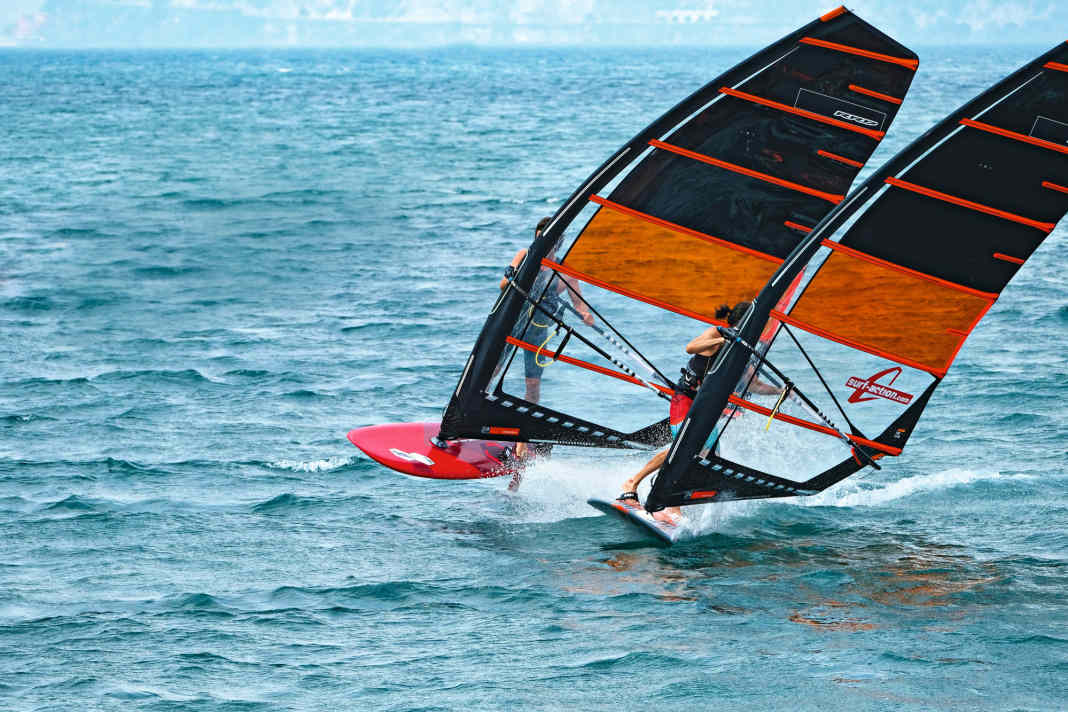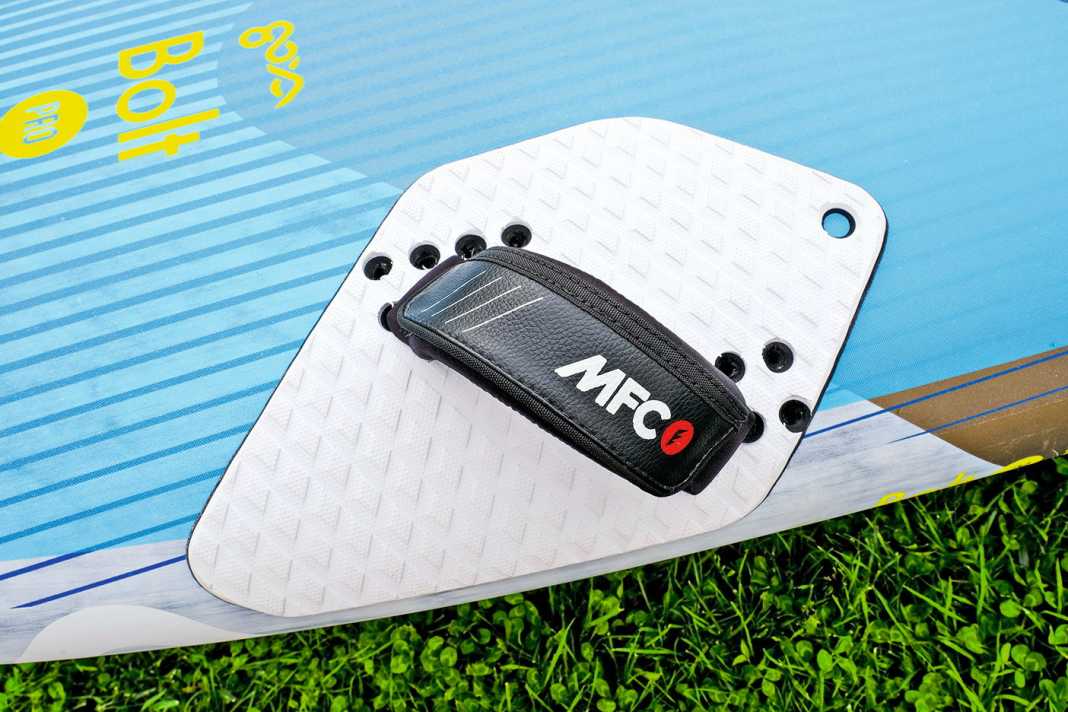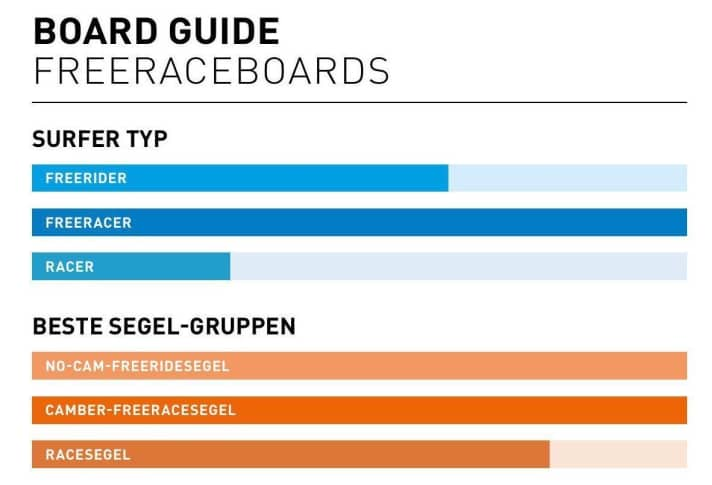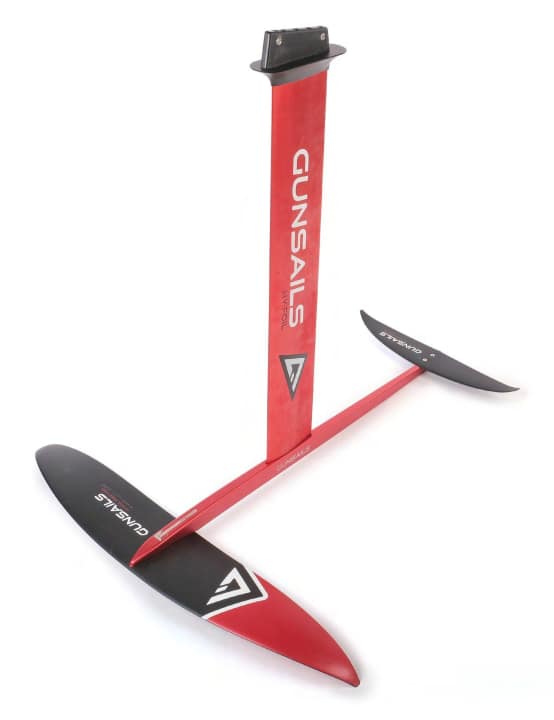





In this article:
These freerace boards are included in the test:
Click to go to the individual ratings
There were supposed to be nine boards for this test. However, the changeable weather of the last few weeks not only made for the most difficult conditions at the Lake Garda test area during the Slalom World Cup in May and extreme hail showers at the beginning of June, but also for long hours waiting for wind for this freerace test. This meant that we were able to check all nine boards for foil suitability and also cover many test kilometres with fins - but not enough to be really sure about the final test score for all boards. Only the five candidates in this issue have already completed the full test programme - we will be presenting the boards from Goya, I-99, RRD and the Tabou Rocket+ in SURF 8-2023 (on newsstands from 26 July). A full comparison of the scores with the boards in this issue will then also be available.
Features and details of the freerace boards
Rarely has a board group been more harmonious in terms of the most important aspect - board width. At 75 and 76 centimetres, the boards are close together and look very similar on the water in terms of size. With the exception of Starboard, all shapers favoured particularly wide tails - which can benefit both light wind performance with a fin and foil suitability.
Within this group of five, the volume of the Fanatic, Patrik and JP Supersport is comparatively evenly distributed, with the Patrik almost classic and the Fanatic with less volume in the bow, but with a very harmonious transition from the thick deck. Starboard and Tabou distribute the volume much more stern-heavy with a more visible transition into the thin bow area. The mast track on the Starboard goes steeply downhill, whereas on the Patrik there is an almost even transition with only about one centimetre lowering of the mast track. The underwater hull tends to have less V and fewer concaves than many freeride boards. These planing surfaces are designed more for performance than for damping. Only the Tabou Fifty has very deep concaves and a very strong V in the area under the mast track.
With the Tabou Fifty, there is a little more space to put your feet in next to the outermost strap position, and with the JP-Australia it is also easier to slip into the outermost position thanks to the slightly flatter deck. With JP, the pads are also pulled particularly far around the rail for good padding under the heel - similar to the Patrik board, which also has the thickest and most comfortable foot pads.
On the Tabou, I-99 and RRD, there is almost no V and only slight double concaves in the area of the fin up to the loops in the underwater hull. In the area below the mast track, a very distinctive V can be seen on all three, with the I-99 GT showing the most pronounced one. On the Goya, on the other hand, a V of around four to five millimetres below the measuring ruler can already be seen at the fin, which continues almost unchanged from the angle to the front, supported by a double concave that is not very spectacular but continues all the way to the bow.
In terms of volume distribution, some of the shapers have placed a lot of fat in the tail, the Goya board is very thinned out towards the front and the Firestorm also has a pronounced hollow in the front of the deck and a fat tail. In contrast, the volume of the Tabou Rocket is distributed very evenly, making the board look almost slim at the rear. The fin screws on the I-99 are not countersunk, which requires ten centimetre long screws in the thick tail, which are not part of the standard range in surf shops. The other features that stand out are the large but not particularly grippy pads on the I-99 and the very wide and soft straps on the Goya Bolt. The pads on the Goya are thin, but have a particularly grippy structure and are pulled as far outwards as possible for large feet. On the RRD, on the other hand, even size 38 feet no longer stand on the carpet at the back with their heels.
The details of the test boards






The surf type recommendations for the freerace boards
The topLight windboards for finsurfingThe Fanatic Jag still hesitates slightly when planing, but then accelerates particularly confidently even in light winds and is a performance tip with its high-end fin. With the Supersport, JP-Australia not only delivers a super glider, but also a fast board for the entire wind spectrum of this volume class. And finally, the Patrik shape also shows its strengths in light to medium planing winds.
AsFreeracer with comfort the Starboard Futura stands out - a board that quickly offers even less experienced surfers maximum potential: cushioned and with maximum stability. But the JP Supersport is also particularly easy to surf. The Tabou Rocket+ is particularly recommended as a slightly more demanding, but also particularly sporty light wind racer. For surfers who are looking for a lot of speed, but a class below extreme race slalom boards.
Only slightly more dynamic than classic freeride boards, the Goya Bolt and RRD Firestorm offer a lot of safety and are particularly easy to surf in this class. The narrower tail of the RRD enables smooth power jibes, while the Goya Bolt also jibes particularly round with a little more pressure. Between the Tabou and the RRD-Goya combination, the I-99 GT is just as tame as the RRD and Goya in light winds and livelier in stronger winds, but not quite as flying as the Tabou Rocket.
For the regularHybrid use with fin and foilTabou's Fifty is the best foil board, but JP, Fanatic and Starboard also come into question from this group. JP and Fanatic foil very stable and well-behaved, but look big. The Starboard Futura flies a little more challenging, but is more compact and sporty. The Patrik board falls a little short in the foil comparison and is more recommended for very occasional foil use.

Strengths and weaknesses of freerace boards
Compared to slalom raceboards, freerace boards are not quite as martially thick at the rear - and are also a few centimetres longer. This makes the transition to planing more harmonious and faster, the standing position is a little more comfortable and the feet are easier to fit into the straps. With consistently good to best planing performance, the boards from Fanatic, JP-Australia and Patrik - along with a few early planing speciality boards - are the top performers in this volume class. The Starboard Futura achieves such good controllability at the other end of the usable wind range that it would also stand out among freeride boards. All freerace boards therefore offer a mixture of performance and comfort that should also be of interest to advanced freeriders. Only the lack of a centre strap or at least double straps that can be mounted particularly far inwards make these boards less suitable for climbing. In terms of glide, these shapes would be completely unproblematic. Only the Starboard Futura conveys more of a slalom race feeling, even when planing, with its very tail-orientated volume distribution - where you shouldn't put too much strain on the bow when catching up with the sail or turning.
On the one hand, the powerful, thick and wide tails offer a lot of potential on upwind courses and allow wind holes to evaporate under the fin. On the other hand, so much volume in the tail does not go unnoticed in the jibe, as tight radii also require a lot of physical effort. Fanatic and JP favour fast carving jibes with a lot of body input and positioning on the front rail, whereas the Starboard Futura glides through the jibe quite easily even with moderate pressure in the classic power jibe technique, steered more via the tail.
This is how well suited the boards are for foiling
All the boards tested are delivered ready to fly with the foil tuttle box. While some may even convince frequent business flyers, others are more suitable for a maximum of one holiday flight per year at economy level.
The idea is tempting: the wind is blowing at 15 to 20 knots - you keep pushing the fin in your 120 or 130 freerace board with the 7.8 sail over the inner-city speed limit. Everything's great so far. But then the wind drops and you're penalised with a family shuttlecock in ten knots of wind. Stop. That's how it used to be! The laws of nature don't change, but nowadays you can change your undercarriage in three minutes at the pit stop and glide on unchecked even in ten knots of wind: with the same sail, but flying low on the foil.
With foil, the range of use can be extended into the single-digit knot range. - Stephan Gölnitz, surf tester
As a test foil, we have a suitable, fast foil for all boards ( GunSails Hy-Foil Free 1050 ), which also gives the boards a good shot of freerace characteristics when foiling: with an early take-off (ten knots are easily possible with a little pumping support) and with a speed potential of well over 40 kilometres per hour.

The foiling ability from the most suitable board (Tabou Fifty) to the least suitable for foiling (Goya Bolt) can be described in school grades as a range - in comparison to pure foil boards - from really good to still sufficient. While the Fifty conveys a really compact flying feeling, is stable in the air and stays up for a long time even in wind holes and gybes, the Bolt requires frequent corrections to the flying height and tends to land prematurely in wind holes and gybes.
All boards have a significantly larger wind range with foil
Even with the Bolt, the wind range can be noticeably extended downwards with a foil, but the flying pleasure on the Fifty is much nicer and more stable. The Tabou Rocket+ is just behind the Fifty. However, with an equally stable position, it requires slightly more tail loading when jibing in order to fly as dry as possible.
Sporty foils with a surface area of 900 to 1100 CM2 are best suited to these boards.
In any case, JP Supersport and Fanatic Jag, two very similar-looking, interesting hybrid concepts, are still foiling in the good to satisfactory range. The Starboard Futura also joins these two, albeit with slightly different characteristics: more agile, but more compact and also very forgiving in jibes with accidental water contact.
Although the Fanatic Jag seems comparatively large when foiling, it is stable in the air with a balanced stance position in the lower and middle foil wind range. The edge hardly brakes at all in the event of an unintentional start, only in hybrid jibes with touchdown on the downwind course does the long, straight edge pull straight ahead more strongly and the jibe is more difficult to steer to the end.
The Goya Bolt Pro, I-99 GT 76, Patrik F-Race 130 and RRD Firestorm 135 still appear to be suitable, albeit with limitations. While the Goya, I-99 and Patrik appear to be quite large and long - and therefore less likely to take off and need to be held in the air more actively in wind holes - the RRD is very compact and conveys an agile flying feeling, but requires more feeling to control the more agile position around the longitudinal axis due to the narrower tail with the smaller loop distance.
Surf summary of the freerace boards
Pure foil boards usually foil better. With a shorter length, foil shapes stay longer and lighter in the air, the thicker rails bounce better out of the water on light contact - on the wide tails, the rear straps are further apart for good leverage and therefore offer optimum control over the foil. However, the Tabou Fifty already comes pretty close to pure foil boards, and the JP Supersport, Fanatic Jag and Starboard Futura also perform well as hybrid concepts for utilising a maximum wind range with fin and foil. With the other boards, the wind range can also be noticeably extended downwind with a foil, with manageable restrictions.
This group offers more performance than the freeride class, while still maintaining good controllability. - Frank Lewisch, surf tester
The Goya board stands out again in the overall very planing group because it slides particularly easily and harmoniously. In the subsequent acceleration phase, the Tabou Rocket is unstoppable and feels like it skips a gear when shifting up, whereas the Goya, RRD and I-99 first have to build up a little more sail pull to get fully up to speed. Even at top speed, the Tabou Rocket with its free planing position hangs on to the leading group of Fanatic Jag, JP Supersport and Starboard Futura. This group flies particularly freely even in medium planing winds, offering good controllability with a high level of riding ability, but only if you can maintain a stable high planing position with technique and body tension. The following applies to all boards: While the speed in the medium wind range is strongly influenced by the natural planing position (Goya, I-99 and RRD plan a little flatter), the top speed can be noticeably improved with a faster fin when all shapes are flying freely.
The grades of the freerace boards at a glance
All nine boards were tested against each other on Lake Garda for the performance grades in comparison rides, the test sail size was 7.8 square metres. Test conditions: Light to strong planing wind, strong chop.






All freerace boards in the individual rating
Click here for the detailed test results of all freerace boards:

